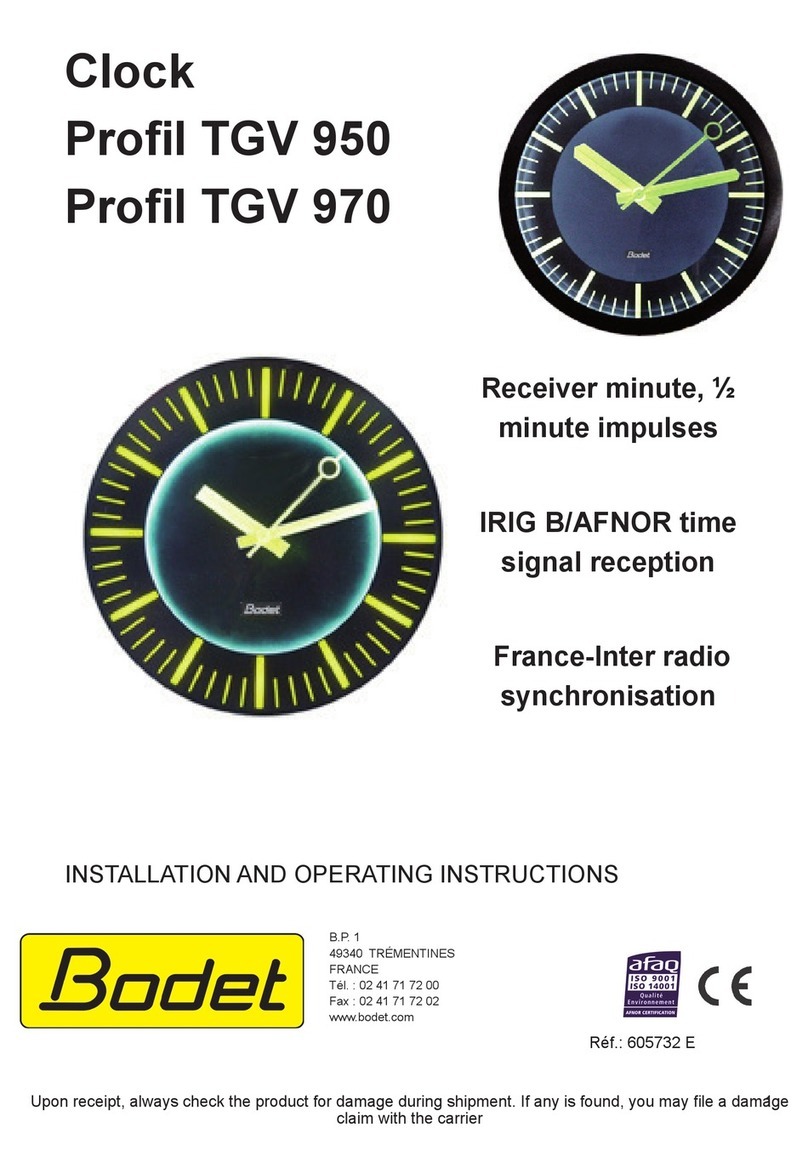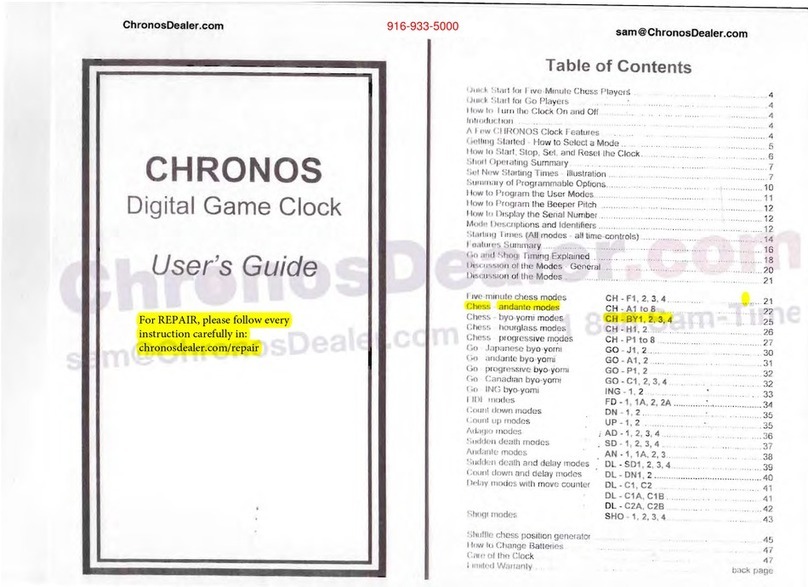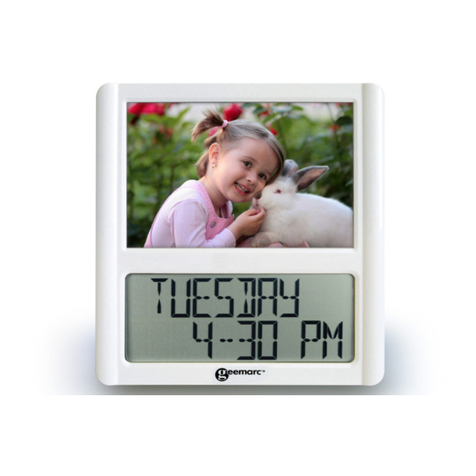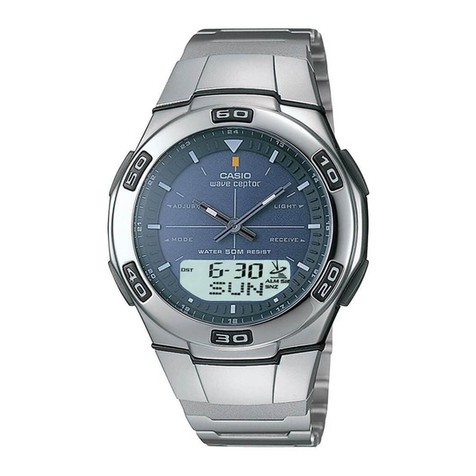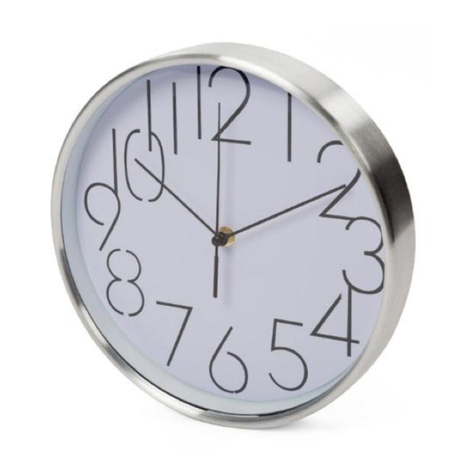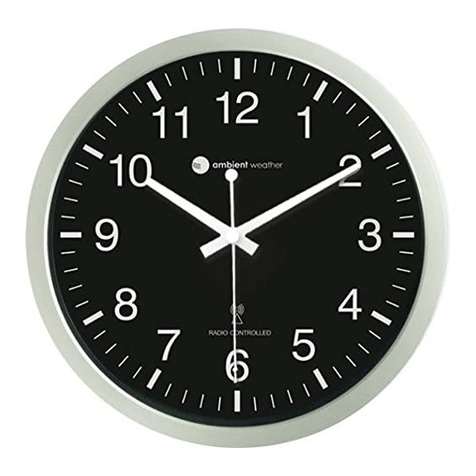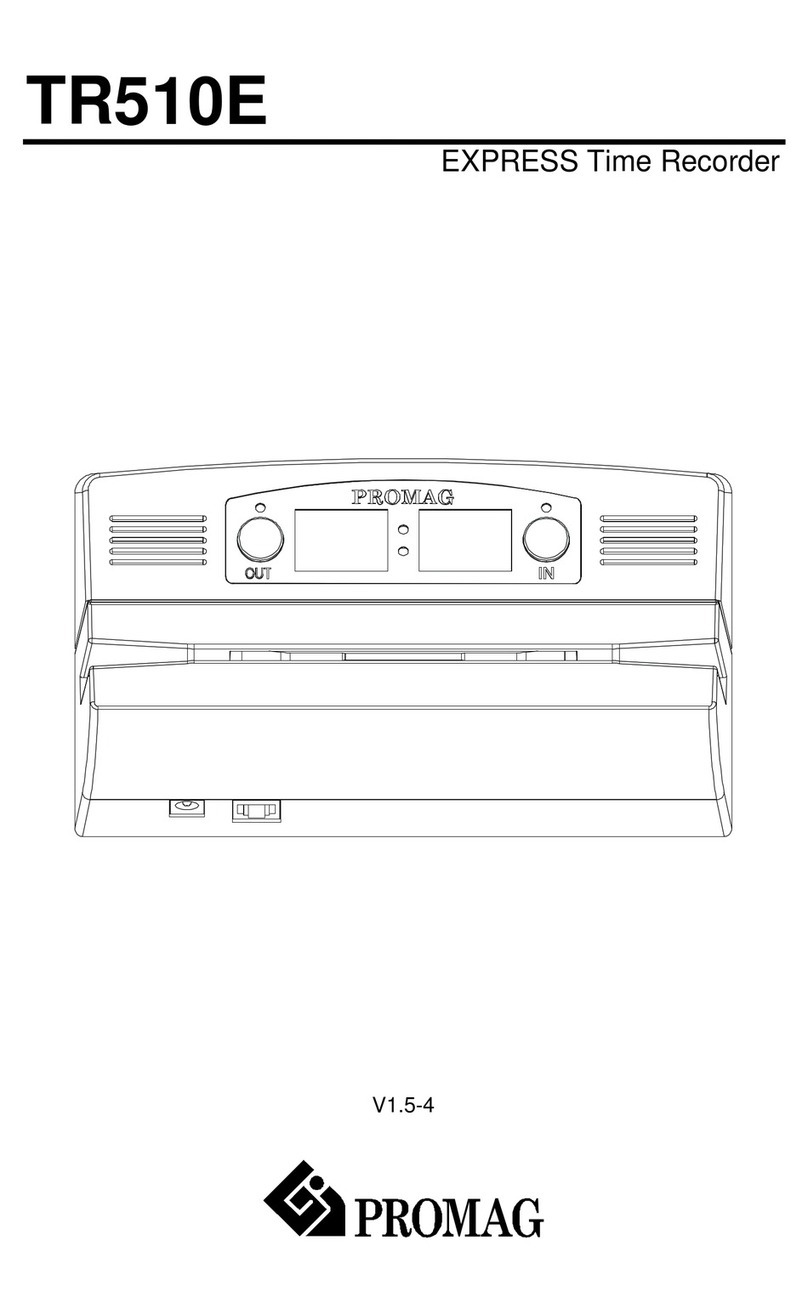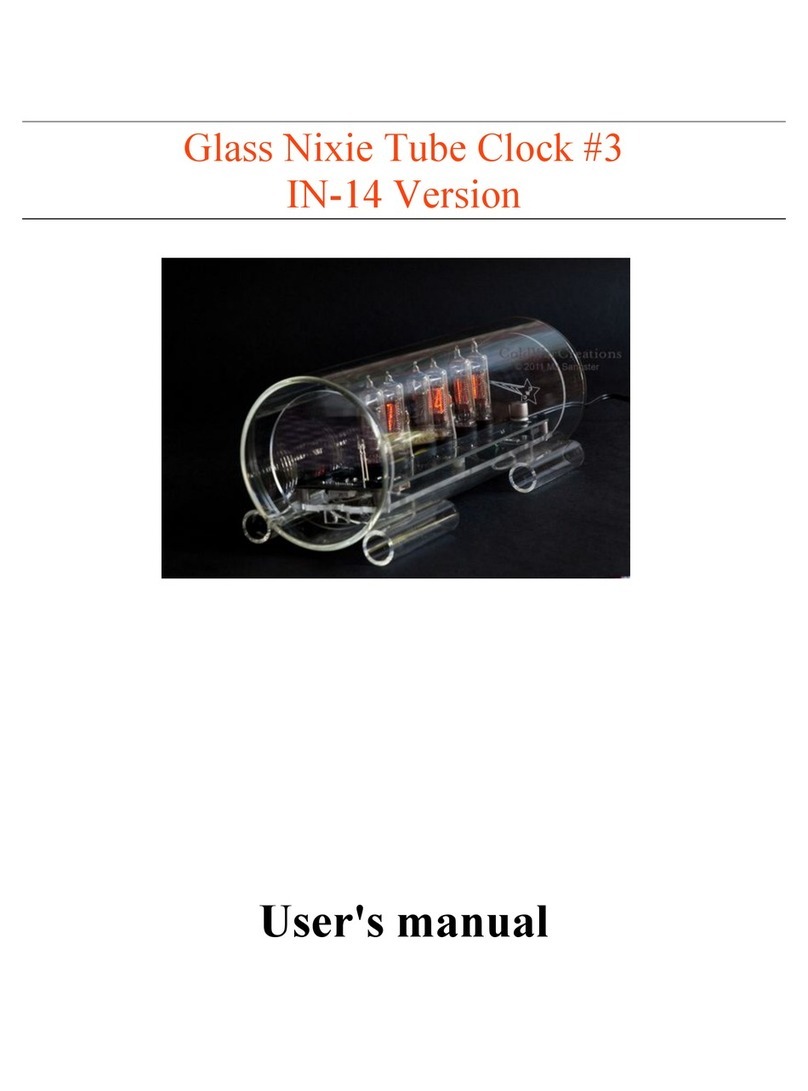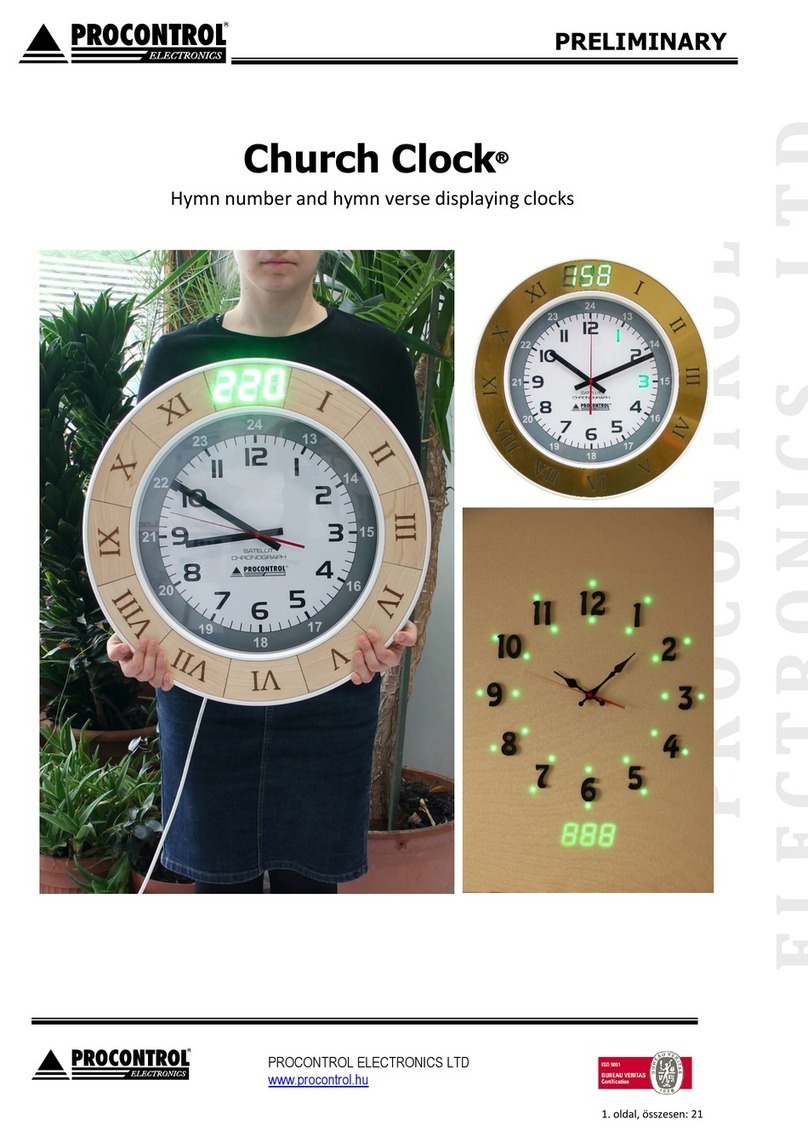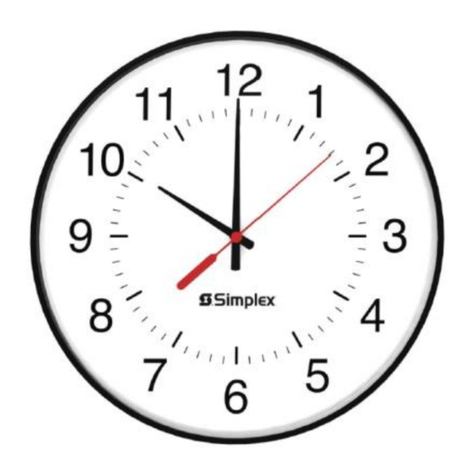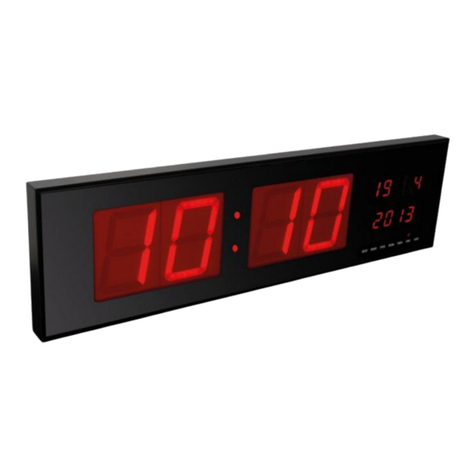ClockWorks Press ATMOS User manual

ATMOS
ThePerpetualMotionClock
Manufacturer'sInstructionsfortheCare,
OperationandRepairoftheAtmosClock.
RevisedEdition

ATMOS
ThePerpetualMotionClock
Manufacturer'sInstructionsfortheCare,
OperationandRepairoftheAtmosClock.
ClockworksPressInternational, Inc.
ShingleSprings,CaliforniaU.S.A.
MilleniumReprintEdition

Copyright© 2000by
ClockWorksPressInternational,Inc.
AllRightsReserved.Nopartofthisbookmaybereproducedor
transmittedinanyformorbyanymeans,electronicormechanical,
includingphotocopying,recordingorbyanyinformationstorage
andretrievalsystemwithoutwrittenpermissionfromthecopyright
holder,exceptforuseofbriefquotationsforreviewpurposes.
ClockWorksPress
International,Inc.
P.O.Box1699
ShingleSprings,California
USA95682-1699
(530)677-7811
www.clockrepair.com
Thispamphletisa reprintofthebookletHow toRepair
Atmos—The Perpetual Motion Clock, firstpublishedby
VacheronandConstantin- LeCoultreWatchesInc.Minor
editshavebeenmadeandillustrationsrevisedand/or
addedtoimprovetheusefulnessoftheoriginalmaterial.
ISBN0-9678671-9-3
CAREANDOPERATIONOFTHE
ATMOSCLOCK
Never move or shift the Atmos Clock before stopping and
locking the Balance Wheel with the Locking Lever on the
base.
1.HowtoRemovetheGlassCaseFromtheClock.
Pulloutthetwopins(A- Figure2)whichholdtheglass
casetothebase.Lifttheglasscarefully.(Ifthestring,
redtag,andwoodenshippingblockhavenotbeen
removed,removethemfromtheclockmechanism.)
2.HowtoLeveltheClock.
Whiletheclockisuncovered,leveltheATMOSby
turningthetwothumbscrewsonthebase(C- Figure
2)untilthebubbleintheroundspiritlevelisinthe
exactcenteroftheliquid.
3.HowtoSettheClock.
Pushtheminutehandwithyourfingerclockwise.
NEVERPUSHTHEHOURHAND.Neverturnthe
handsforsettingwhiletheimpulsepinengagesthehorns
oftheclock.
4.ReplacetheGlassCase.(F- Figure2)
5.HowtoStartandStoptheClock.
Tostart,pushthelockingleveronthefrontoftheclock
base(B- Figure2)slowlyfromrighttoleft.Thisstarts
thebalancewheeltooscillateslowly.Tostopandlock
balancewheel,pushlockingleveronthebasefromleft
toright.
6.NeverTouchtheBalanceWheel.
3

INSTRUCTIONSONTHEREPAIROF
ATMOSCLOCKS
Tosecurea goodperformancefromtheclock,itisessential
thattheATMOSbeplacedona stablesupportandinan
absolutelyhorizontalposition.Thelattercanbecheckedby
thebuilt-inspiritlevelG (Figure1)locatedinthebaseatthe
frontoftheclockandalsobythebalanceitself.Itsufficesif
thebankingstemM whichisfixedonthebalancestaff,is
Figure1
ShowingFrontofClockwithMovementRemoved.
centeredoverapertureL inthebridgethroughwhichitpasses.
Forrepairwork,followthesesteps:
1.Checkthehorizontalpositionoftheclock.
2.Checkifpowerreachestheescapementbygently
slidingthelockinglevertotheleftandtherebyreleasing
4
balancefromitslockedposition;theoperationofthepallets
canbeobservedthroughthesmallholesmadeforthispuipose.
Theholesarelocatedonthefrontplateofthemovementat
thetopoftheplate.Watchfora kickingactionontheforkas
eachpalletdropsoffanescapewheeltooth.Thisshows
whetherthereispowertotheescapewheel.
3.Checkifhandsmovequitefreely.
4.Checkconditionofthemotor.(Seepage13)
Havingmadethesefourchecks,lockbalancewheelby
depressingandslidingthelockinglever(B- Figure2)from
lefttoright.ThenremovehandsbymeansofTool4 (Figure
5),alsoremovethedialanddialbezel.Intheabsenceofthe
factory-madehandremovingtool,a suitabletoolcanbemade
byconvertinga smallhandremovingtoolforuseonATMOS.
Thekeyrequirementisthattheplungermustbenolarger
than0.6mm(.024").TheATMOSminutehandmustonlybe
removedusinga handremovingtool.Theminutehandshaft
issosmall,thatanyothermethodwilllikelyresultindamage
totheshaft.
Afterremovingthehands,itisworthwhiletocheckthe
handsforbalance.Thehandsmustbeperfectly
counterbalanced.A poorlypoisedminutehandwillstopthe
clock;a similarlyfaultyhourhandwillcausevariationofas
muchasa quarterturnintheamplitudeofthebalance.
Themovementisremovedbyunscrewingthetwo
mountingscrews(oneoneachsideofthemovement)from
themountingstuds(Z- Figure1).
Whenremovingthemovement,caremustbetakennotto
bendthefork,nortoletthegear-trainrununcontrolled.Hold
5

Figure2
thefirstwheel(Thelargewheelthatengagesthebarrelgear.)
soastobeabletocontrolthespeedoftheBarrelasitruns
down.CounttheturnsoftheBarrelwhilereleasingthetrain.
Normallythiswillrequire5 to7 revolutionsorturnsofthe
springbarrel.Lessthanthismayindicatethattheclockwas
notwindingproperlypossiblyindicatinga problemwiththe
bellowsormotor.(Note:RegulatorknobD aboveonlyin
modelspriorto1951.)
6
Aftercompletelyunwindingthemainspring,removethe
motorbyunscrewingthefourmotormountingnuts(I- Figure
1),usingKeyNo.5 (Figure5).Intheabsenceofthefactory-
madetool,an8 mm(5/16inch)spanneroropen-endwrench
canbeused.ForCaliber540models,themotorisremoved
byrotatingthemotorunitina counter-clockwisedirection.It
isona bayonet-typemount.
Whenthemotorandmovementhavebeenremoved,see
ifthebalanceiswellpoised.Ifitis,thesmallrolleratthetop
ofthebalancestaffwillbeconstantlycenteredonthe
regulatingclampasthebalancerevolves;thisistoprevent
therollerfromevertouchingtheclampwhiletheclockis
running,despitetheslight,inevitableto-and-fromovements
whichoccur.Ifthisconditionisnotfulfilled,re-adjustthe
balancetubebybendingitverygentlyaslittleaspossible.
1953Atmos
WithCoverRemoved
7

Next,unscrewthe6 screwsofthestandandbaseplateto
freetheframeworkfromthebase.
Tofreethebalance,unscrewregulatingclampscrewJ
andwiresleevescrewK (Figure3).Gently,pulloutpinN
whileholdingupthebalance;thengentlydisengagethe
balancebyraisinguptheframework.Seethattheregulating
clampdoesnotremainlockedintheregulatingsleeve.(There
mustbenodangerofthewirecomingintocontactwiththe
apertureinthesmallroller,butmustbeprotectedbythe
clamp.)
Figure3
Whenbalancehasbeenremoved,checkwinding
mechanismasfollows:
Towindthemainspring,compressthebackspringH
(Figure4)inthehand.(Stopmovementofgear-trainandallow
Figure4
BackSpring
backspringtoreleaseitselfasmanytimesasnecessary.)When
backspringiscompletelyexpanded,itisequilibratedwith
mainspring.Thelattermustneverbewoundmorethanthe
backspringcanwindit.Ifthemainspringisoverwound,the
movementwillbank.Duringthisoperation,countthenumber
ofrevolutionsofthebarrelrequiredtowindmainspring.When
thespringsareequilibrated,tosecurethebestworking
conditions,themainspringshouldbewoundtoa minimum
of5 revolutionsanda maximumof7 revolutions.Thewinding
ofthemainspringceasesabruptly.Ifitdoesnot,thatistosay,
ifthebackspringcontinuestowindthemainspringwitha
smallmomentum(by2,1,oreven1/2ofa ratchetcogata
time),itsignifiesthatwindingisnotbeingoperatedunder
9

goodconditions.Thecausesforthisarethefollowing:
1.Thebackspringmaybewarped,evenslightly(1or2
spirals).
2.Lengthofthesmallchainmaynottallywith
requirements:itshouldbesufficientlylongtoallowa
maximumexpansionofthebackspringfrom45to48
mm(1.77to1.89inches)fromplate.(Seefigure4).
3.Thechainmustnotbetwisted.
4.Thepulleyfixedtotheplatemustmovefreely.
Next,seewhethertheregulatingmechanismisingood
order.TherotatorymovementofregulatorR (Figures3 and
6)mustfrictionallydriveregulatortubeV andtherebyimpart
averticalmovementtoregulatingsleeveX (Figure3).
Figure6
10
Whentheframeworkhasbeencompletelydismantled,
checkthatpivotholesoftheintermediatewheelandthebarrel
pivotholesarecleanandwellpolished.Thesethreepivot
holesaretheonlypartsoftheclockmechanismwhichshould
beoiledbesidesthelubricationofthemainspring.Thethree
pivotholesmustbeslightlyoiledwitha fine,nottoofluid,
lubricant(ChronaxD orE,orMoebiusNo.3).Alsolightly
lubricatethemainspring.
Whenthegear-trainhasbeenremounted,useChainHook,
ToolNo.2 (Figure5)toreplacebackspring.A smallhook
canbefashionedfroma pieceofstiffwire.
Intheeventoffaultyadjustment,checkonefactorvery
thoroughly,vis.,thesuspensionwireanditsregulating
mechanism.
Tounscrewbalance,useKeyNo.6 (Figure5)tounlock
suspensionwireclampingscrewinsidethebalancetube.
Whenthisscrewhasbeenremoved,thewireshouldappear
inthescrewarborlyingstraightwithoutbendortorsion.It
mustbeheldverytightlyinthescrewtopreventitfrom
slipping.Throughthemediumoftheregulatingmechanism,
theregulatingclampallowsforreadjustmentsbyalteration
oftheworkinglengthofthewire.Theclampmustgripthe
wirelightlybutsufficientlyfirmtocarrytheheavyweightof
thebalancesecurely.Thetwolipsoftheclampmustlie
perfectlyparalleltooneanotherandholdthewireattheir
extremities.
Theinside ofthebalancetube,(M- Figure1)which
passesthesuspensionwire,mustbeabsolutelyclean.
Theimpulsepinmustmoveperfectlyfreeonitsstaff.
11
RegulatorTool

Toreplacethewireinsidethebalancetube,useTool
No.3 (Figure5).Whenthebalancerollerunithasbeen
remounted,suspenditontheframework.Todothis,useTool
No.1 topushthewireinsidetheupperbridgeanduseTool
No.8 (ring)toraisethebalance.Useplierstodrawtheendof
thewireuntilbankingstemM (Figure1)liesunderlower
bridgeP.Insertsuspension-wirepinN (Figure3),pressit
downwhilestretchingthewire,givea lightblowonthepin
inordertomakewireslipandreleasebankingstemfrom
lowerbridge.ThelowerbridgeP (Figure1)mustdividethe
spacebetweenthetwoplanesofbankingstemM equally,the
regulatingclampmustbetightenedandmakesurethatthe
wireissuspendedinthecenterofthetube.Theremustbeno
twistingortorsionofthewirebetweenthepointwhereitis
attachedtothewiresleevebythepinandthepointwhereit
liesinsidethethreadedclamp.
Checkwhetherthebalanceispoisedandengagesthe
escapement.ForpoisingseePage7.Thebalanceengages
whentheimpulsepinliesforwardwhilethebalanceisdead
centre.Ifthisisnotthecase,turnrollerthroughdiskO (Figure
3),afterhavingreleasedthescrewofsaiddiskO.Thencount
oscillationsofbalancefor15minutes.Ifvariationexceeds1
second,moreorless,per15minutes,adjustthebalanceby
addingorlesseningoscillatingandregulatingweights.
1mmofoscillating weight= 8 secondsper15minutes.
1mmofregulating weight= 4 secondsper15minutes.
Thetwosetsofoscillatingandregulatingweightscanbe
comparedona verysensitivepairofscales,sothat,whenset
inplaceonthebalancewheelitself,thelatterwillnotbeput
outofpoise.Assoonassufficientlyaccuratetiminghasbeen
obtainedbyadjustmentofthesesetsofweights,thefinalrating
12
canbeobtainedbyregulatorR (Figures3 and6)whichallows
forexactdeterminationoftherequiredadjustment:
1division= 10secondsper24hours
Ifvariationexceeds50secondsper24hours,adjustfor
50secondswhentheregulatorisinthemiddleofitsrun,by
displacingthelattertoleftorright;thenlockregulatortube
V(Figure6)withappropriateToolNo.10(Figure5)andpull
regulatorinoppositedirection(itwillturnwithoutmodifying
adjustment)andfinishadjustingafterhavingfreedthe
regulatortube.
Thenreplacebaseplateandcheckforgoodoperationof
balancelockingmechanism.
Shouldthemovementrequireoverhauling(useToolNo.
7-MovementHolder)wewishtostressthat,owingtothe
minimumpowerwhichistransmittedandtheslowmovement
mechanism,allwheelsandpinionsmustbecleaned,(not
lubricated)andrunperfectlyfree.Thesurfacesofrestand
impulseofallrunnersmustbeperfectlypolished,thepallets
verycleanandthelocksslightwithonlya smallbacklash.
Carefullyobservepoiseoftheforkwhichissuspended
bythetwopivotsofthepalletstaff(likea watchbalanceon
thepoisingtool);theforkmustbeslightlyheavieronthe
hornside,tosecureonecompleteoscillationperminute.At
rest,theforkmusthavea perfectlyverticalpositiononthe
tool;ifnot,correctbyaddinga counterweightasrequired.
(Thisslightfaultinpoiseisimportantforitmaypreventgood
timing.)
Whenthemovementisremounted, putitbackandalso
checkthegoodoperationoftheescapementandthefork.If
13

theclearancesoftheguardpinsareirregular,turnthepallet
forkslightlyonitsadjustment.Ifforsomereasonorother,
thearchoftheforkhadtobere-adjusted,caremustbetaken
tosecureperfectpoise.Theescapementisregulatedbythe
pinsattachedtothe3/4plate,asthebankingpinsfixedtothe
upperbridgesomeintooperationonlyinthecaseofover-
banking.Allowa spaceof2 to3/100thmmbetweenthehorns
oftheforkandthebankingpinsofthebridge.
Itiseasytocheckimmediatelywhetherthemotorisin
goodworkingcondition.Ata temperatureof18to20C (64.4
to68F)studsT (Figure1)fixedtotheinsidebaseofthe
motor,arevisiblea fewmillimetersbehindthebackplate
(throughthecorrespondingholesinthebackframe).
At25C (77F)theyappeara fewmillimetersaboveT.If
themotor(diaphragm)isinbadcondition,thebaseis
completelycollapsedandtouchesthebottomoftheinside
case;evenat25C (77F),itwillremaininthesameposition,
whereasa motoringoodconditionwill,atthistemperature,
completelycompressitslargeinnerspringandthestudswill
befullyvisible.
Insidethesealeddiaphragmisa gaswhichactsona
flexiblemetalmembrane.Undertheeffectofvariationsof
temperature(andalsoofatmosphericpressure)itcontracts
andexpands,thuscausingdisplacementoftheinnerbase.
Whenthetemperaturerises,themotorcompressestheback
springH (Figure4)oftheclock(invisiblewhenthemotoris
inplace)towhichthechainisfixed.Whenthetemperature
decreases,thebasecontractsandallowsthebackspringto
expand.
14
Themotoroperateswithintemperaturelimitsof8 to30C
(46.4to86F).Beyondtheselimits,themotornolongerwinds
uptheclock,butthemainspringhasa normalminimum
runningreserveofoneyear.
Withinthelimitsspecified,themotorobtainsfromthe
variationsofambienttemperature,a drivingpowerseveral
timesgreaterthanthatrequiredtokeepthebalancegoing.
Thepowerofthebackspringiscalculatedsothatitcannot
windthemainspringbymorethan5 to7 turns.Assoonas
thespringreachesthisamountoftension,themotor"idles"
until,whena smallfractionofpowerhasbeenabsorbed,the
backspringagaincomesintocontactwiththebaseofthe
motor.Thissignifies,practically,a constantdrivingpower.
Itisatthispoint,thatistosay,atthemaximumatwhich
thebackspringisabletowindthebarrelspring,thatthe
amplitudeofthebalancewheelturnsshouldbechecked.It
willhavetobeaboutoneanda halfturns.
In90%ofATMOSrepairwork,thereisnoneedto
dismantlethebalancecompletely.Itisusuallysufficientto
cleanthemovementandcheckwhetherallofthepartsoperate
freely.Iftheclockreallydoesnotgivesatisfaction,thenonly
isitnecessarytodismantlethebalanceandthesuspension
wirecompletely.
15

1.Tubepermittingpassageofwireinsidetheupperbridge.
2.Tooltopullthechaintoinsidefrombehindthespring.
3.Tooltopasswireinsidethebalancestem(tube).
4.Toolforremovingtheminutehand(handpuller).
5.Keyforremovingthemotor(8mmspanner).
6.Keyforremovingthecylinderwhichattachesbalance
tothebalancecanon.
7.Movementholder(seenextpage).
8.Ringtoraisethebalancetoallowsuspension.
9.Toolforcenteringbalancebybendingthetube(poise).
10.Toolforholdingtheregulatingcanonwhilemoving
theregulator,(regulatorspanner).
16
DetailofBalanceTube
PoisingTool
17
Popular Clock manuals by other brands
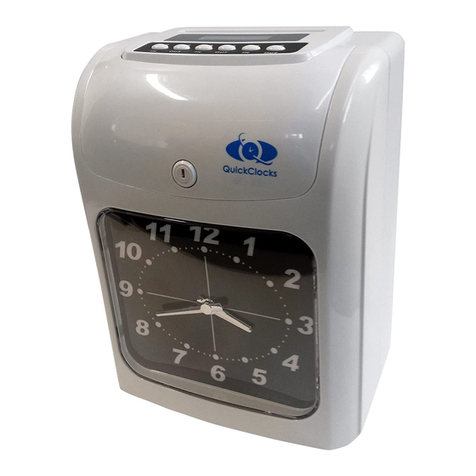
QUICKCLOCKS
QUICKCLOCKS QC500N Operation manual
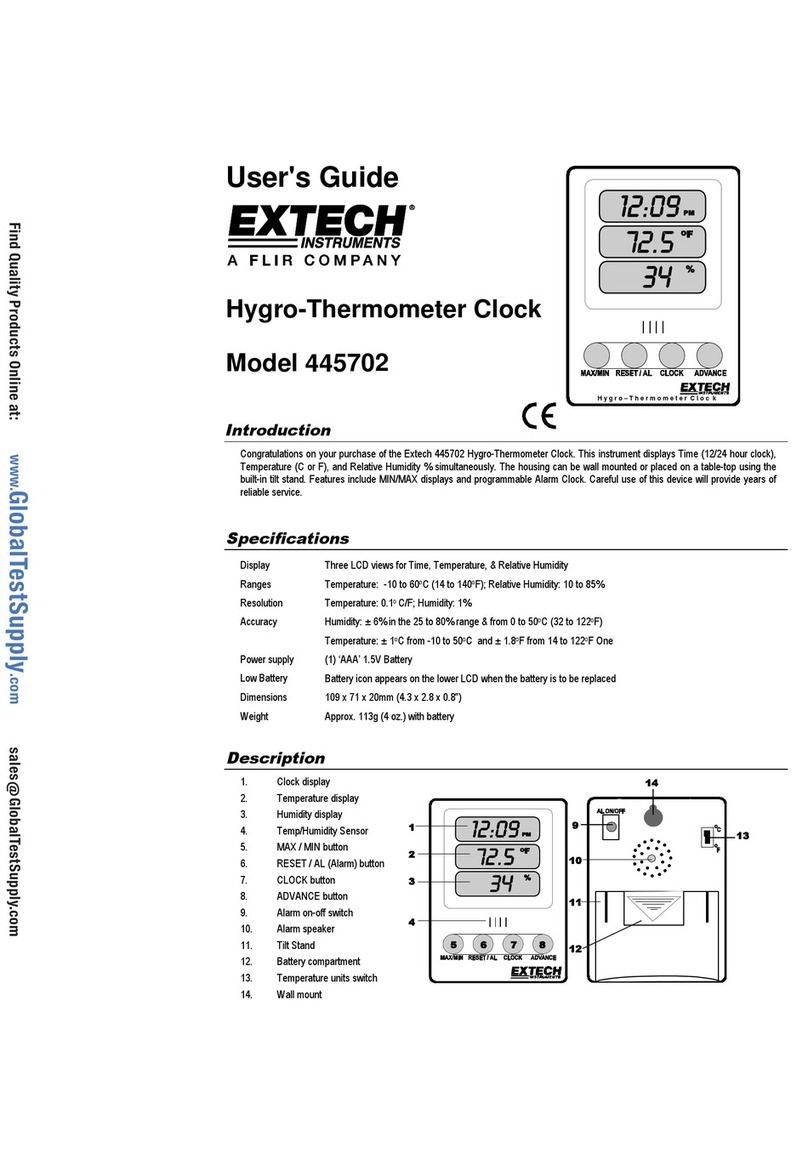
FLIR
FLIR Extech 445702 user guide

La Crosse Technology
La Crosse Technology WT-3122A manual

Pepperl+Fuchs
Pepperl+Fuchs ecom Ex-Time 40 operating instructions
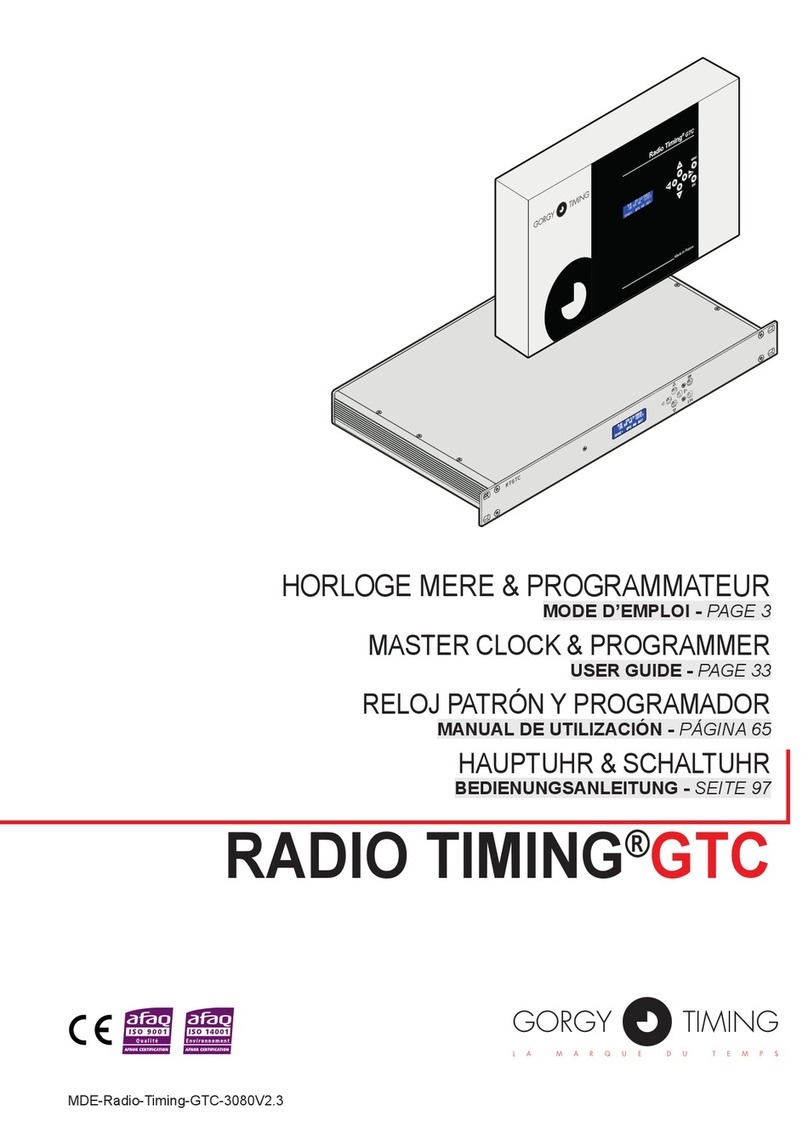
Gorgy Timing
Gorgy Timing RADIO TIMING GTC user guide
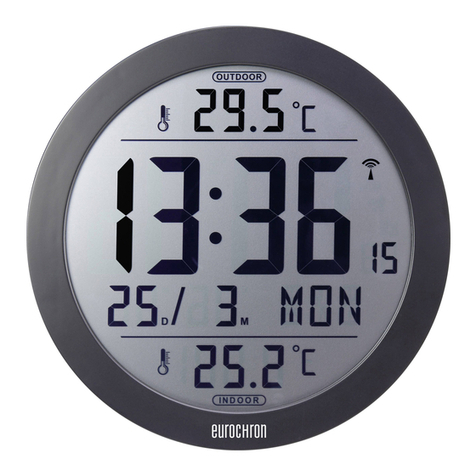
Eurochron
Eurochron KW-9324RF operating instructions
